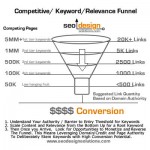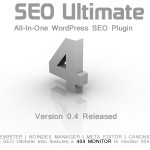Getting link equity out of a website means that every link used to (a) link to another page or (b) leaving any page is optimal for passing on hierarchical intent to the page it links to. In other words, make each link count. Although the ramifications of this type of analysis and implementation are indigenous to SEO, it works hand in hand with site architecture and is the next layer in sculpting the ideal user experience.
By managing link equity within a site properly you can (1) restructure how a website ranks in search engines (2) what it ranks for (3) aid in indexation of pages or offsetting supplemental results and (4) which new pages or site segments become a hub (like the center of a wheel) capable of funneling or directing traffic and ranking for multiple keywords and key phrases on its own.
Link equity is something you should invest time into (right after keyword research and site architecture) to get optimal and sustainable long-term and ROI from your website.
Link Equity is Like Ranking Credits
Consider link equity as a websites internal monetary currency and wherever you spend it, should be an area that is intended to “stand out from other less important pages” in a site. Think of link equity as ranking credits, you just have to be aware of how you spend it. For example, a contact form, login page or privacy policy is not the best place to spend link equity, but a product or category page is, since it can feed an entire array of other more suitable landing pages for users.
The key is to (1) diversify link anchor text but also (2) be aware that a page that ranks for a keyword, is best used to help another page rank for a related keyword. Using each page like the buddy system or daisy chain, you can pull entire segments into the spotlight from tactfully reinforcing site segments with overlapping instances of co-occurrence, natural language and / or synonyms or off page ranking factor to solidify rankings.
Avoiding SERP Stagnation
It is important to avoid pages siphoning off their link flow and receding in the SERPs (search engine result pages). You can minimize the chrysalis phase (like when a caterpillar turns into a butterfly) by insulating your content or creating a method to ensure it is nourished in its cyclical down-time.
SEO has various cycles; if you work in tandem with the natural tendencies of these search engine / SEO cycles, then rankings are merely a by-product.
Depending on the size and authority of your website, each cycle has a unique effect. For example new pages rise quickly (from the fresh content or fresh link factor) then lapse when the primary page ages, loses relevance, lacks internal links or fails to get validation from peer review (inbound links from other sources).
Wherever a page is in the cycle, there is hope as with energy, effort and attention, you can resuscitate it, or create a new page to augment a site sagging under its own weight. One thing to keep an eye on is how buoyant your content is and when it either recedes, compounds itself and reappears (either stronger or normalized to a weaker extent) of fades away into the supplemental index.
Also, trimming the fat can include determining which pages are most suitable for engagement. You can still have a page aiding in rankings, but “off the grid” and out of the index “so to speak” to not create duplicate content.
Using a simple, noindex, follow command in the page header’s meta data is more than enough to indicate to spiders to pass this pages link flow along, but keep the page itself on the sidelines (and not ranking or diffusing rankings) for more prominent pages.
SEO Quality Control
Search engines reward unique content, and aside from meta data and content, how you structure your internal links determine which pages in a website are most important.
Look for ways to revive keyword clusters by using synonyms based on semantic parent themes, each page represents a relative position or rung on the ladder that can aid the positioning of yet another keyword cluster.
A keyword cluster is a group of related keywords that can be tied together to conquer a competitive vertical or series of specific “exact match” rankings. By tracing the link trail a.k.a link graph and determining which page is linking to it (and this passing along its vote) or how it fits into the overall site strategy becomes more important when dialing in specific rankings.
For example, by using a simple search operator such as site:yourdomain.com/page.html in Yahoo, then selecting (inbound links) will allow you to trace the extent of how well a page is internally linked. Just select [from all pages] using the drop down menu to then see which pages are providing internal links from within your own site.
If you wanted to see which anchor text was used, then use this plugin in tandem with Firefox from Joost De Valk to see which pages have which anchor text pointing at them. A more detailed explanation of this SEO technique is covered in this on page SEO module.
There are of course more advanced tools to track, identify and map out internal link percentages, anchor text, deep link ratios and the like, but this should at least bring the necessity to the forefront that how you link to yourself both contextually (in the content) and using primary and secondary navigation is of the utmost importance for SEO.












Thanks for the detailed description of link equity.Hearing about it for the first time.
Blog is quite nice,i comply by your opinion…thanks.
Hi this is wdesign
insulating your content or creating a method to ensure it is nourished in its cyclical down-time.
Great post! have heard this term here and there for last few months, now got the complete idea.
Thanks